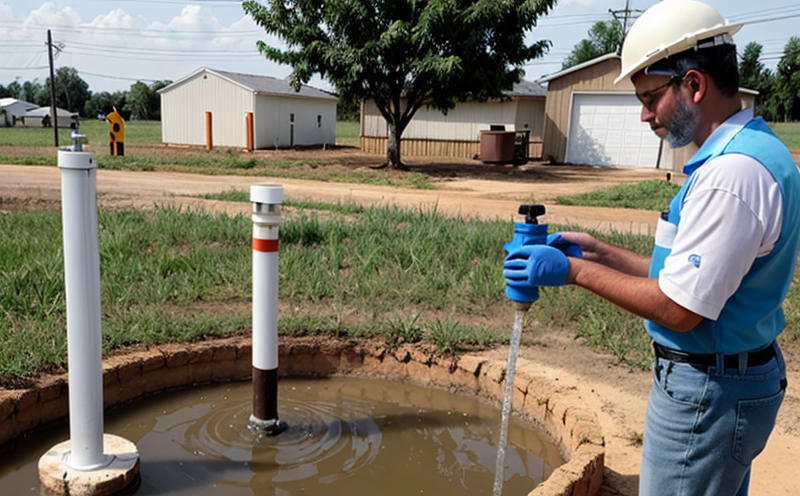ISO 15923-1 Fluoride Determination in Groundwater
The determination of fluoride in groundwater is a critical process to ensure compliance with international standards and to safeguard public health. ISO 15923-1 provides a standardized method for the accurate quantification of fluoride, which is essential for monitoring water quality parameters that can impact human health.
Fluoride is naturally present in many groundwater sources but at elevated levels can lead to fluorosis and other health issues. The World Health Organization (WHO) recommends a maximum permissible level of 1.5 mg/L of fluoride in drinking water. This standard aims to prevent dental caries while minimizing the risk of fluorosis.
The procedure outlined in ISO 15923-1 involves several key steps: sample collection, digestion, and subsequent determination by spectrophotometry or ion chromatography. Proper specimen preparation is crucial as it directly impacts the accuracy of the results. The method requires precise handling to avoid contamination and ensure that the fluoride ions are liberated from any bound forms.
The instrumentation used for this analysis typically includes a pH meter for adjusting sample acidity, a microwave digestion system for breaking down complex compounds, and an ion chromatograph or spectrophotometer for measuring fluoride concentrations. The use of these advanced tools ensures high precision and reliability in the results.
Accurate reporting is also essential for effective monitoring and compliance. Results should be presented with appropriate units (mg/L) and accompanied by a detailed methodology section that includes all necessary details for replication or verification by other laboratories.
The importance of this service cannot be overstated, especially in regions where groundwater is the primary source of drinking water. Regular testing helps in identifying any potential issues early on, thereby facilitating timely corrective actions to maintain water quality standards.
Why It Matters
Ensuring that fluoride levels in groundwater are within safe limits is not just a technical requirement but also a public health imperative. High concentrations of fluoride can lead to dental and skeletal fluorosis, which affects bone structure and function. Children are particularly vulnerable to the adverse effects of excess fluoride intake.
From an environmental perspective, monitoring fluoride levels helps in understanding the natural occurrence and anthropogenic influences on groundwater quality. This information is vital for developing sustainable water management strategies that balance human needs with ecological considerations.
Compliance with international standards such as ISO 15923-1 is essential to ensure consistency and reliability across different jurisdictions. It provides a common ground for laboratories worldwide, promoting trust in the results and facilitating easier inter-laboratory comparisons.
Industry Applications
Table of Groundwater Quality Parameters:
| Parameter | Description | Unit |
|---|---|---|
| Fluoride | Total fluoride content in the sample. | mg/L |
| pH Level | Acidity of the groundwater sample. | – |
| Nitrate Nitrogen | Presence and concentration of nitrate nitrogen in the water. | mg/L |
| Total Dissolved Solids (TDS) | Sum of all dissolved solids in the sample. | mg/L |
List of Groundwater Testing Requirements:
- Detection and quantification of fluoride levels.
- Evaluation of pH levels to assess water acidity or alkalinity.
- Monitoring nitrate nitrogen content for potential contamination from agricultural runoff or sewage discharge.
- Assessment of total dissolved solids to gauge overall water quality.
The monitoring and analysis of these parameters are crucial for maintaining the integrity of groundwater resources. This information is vital for regulatory compliance, public health protection, and environmental stewardship.
Eurolab Advantages
At Eurolab, we pride ourselves on delivering accurate, reliable, and timely fluoride determination in groundwater according to ISO 15923-1. Our team of experts ensures that every sample is handled with utmost care from collection to final analysis.
- Precision: Utilizing state-of-the-art instrumentation, we guarantee precise results that meet international standards.
- Consistency: Each analysis adheres strictly to the ISO protocol ensuring uniformity across all tests.
- Expertise: Our scientists and engineers are trained in the latest methodologies ensuring accurate and reproducible results.
- Compliance: Our services comply with international regulations including ISO 15923-1, ensuring that your data is valid for global use.
We understand the importance of this service to our clients. By providing high-quality testing and reliable results, we contribute significantly to maintaining water quality standards and protecting public health.





